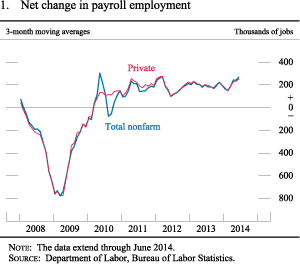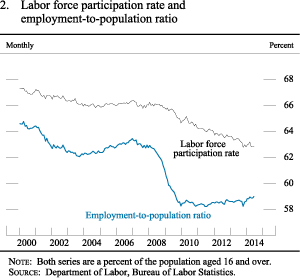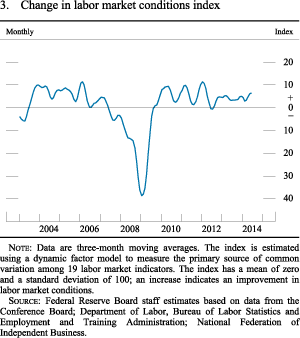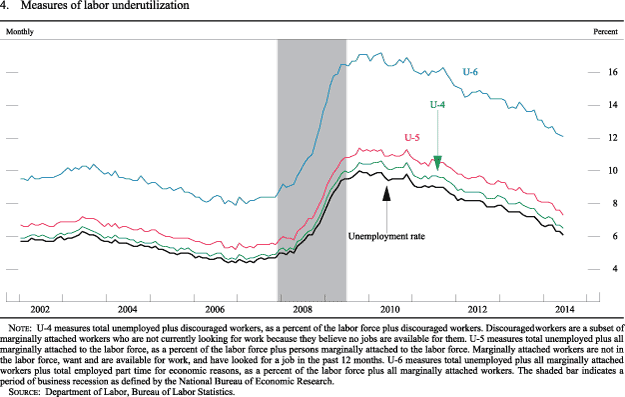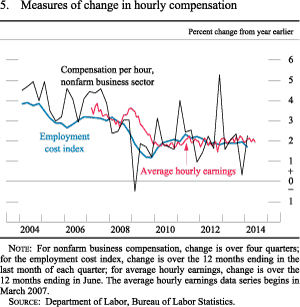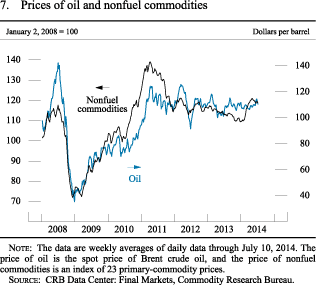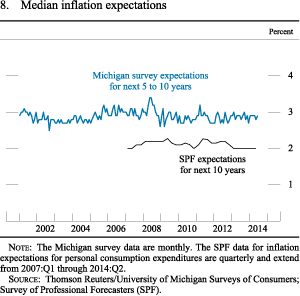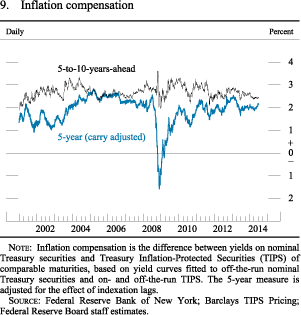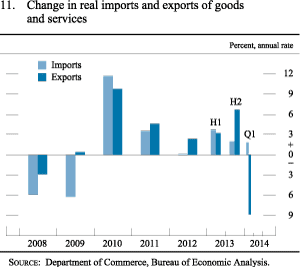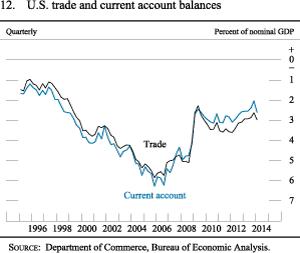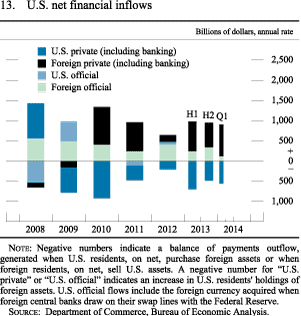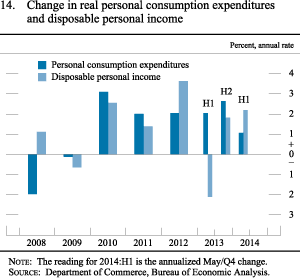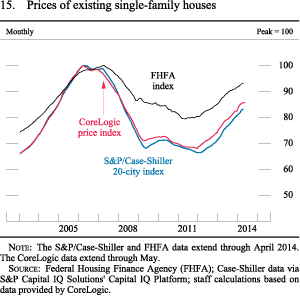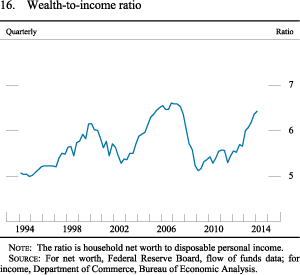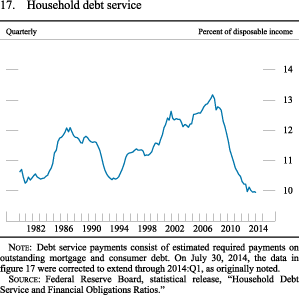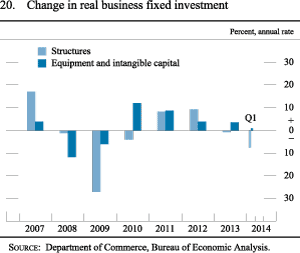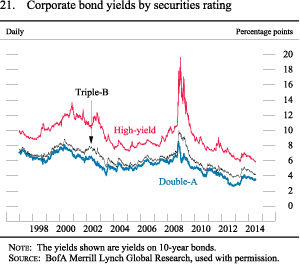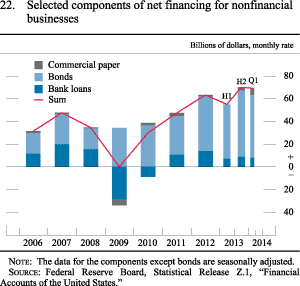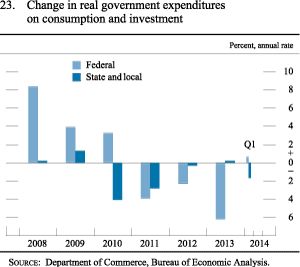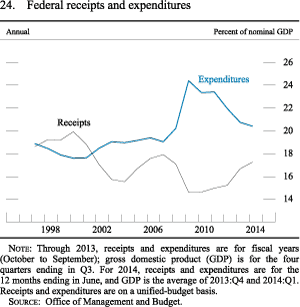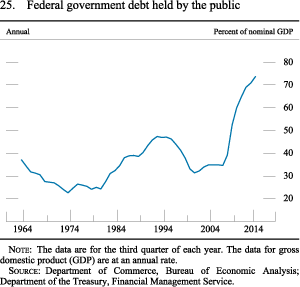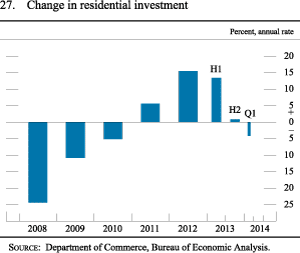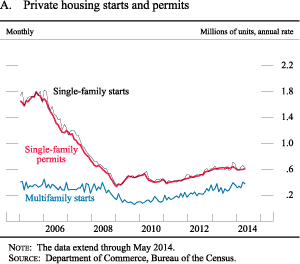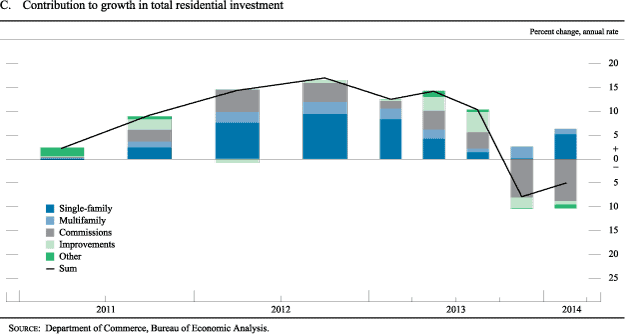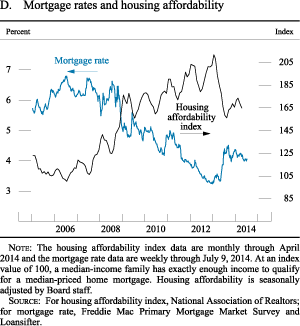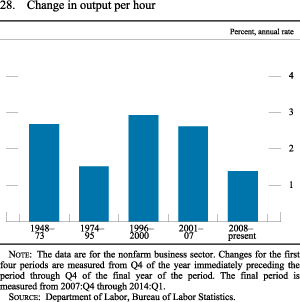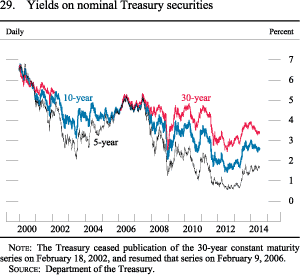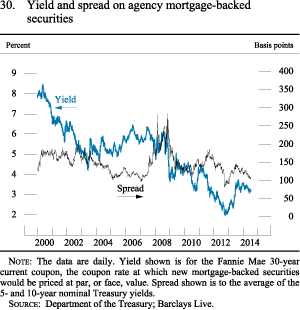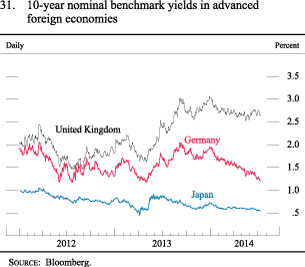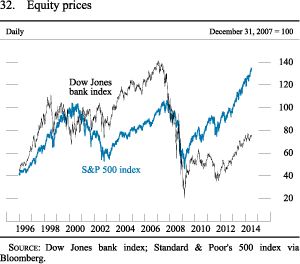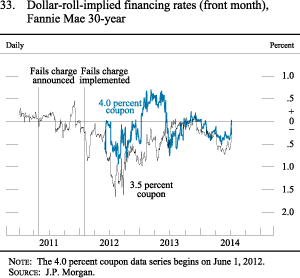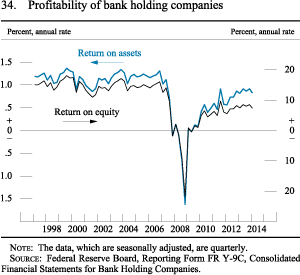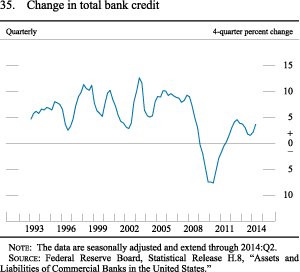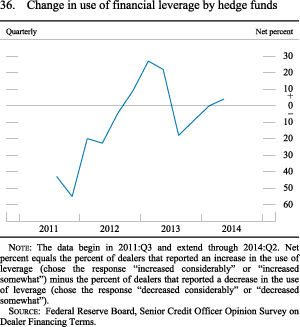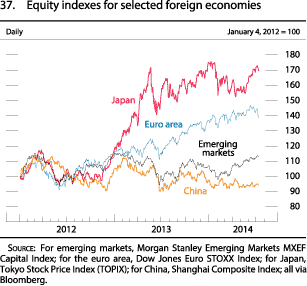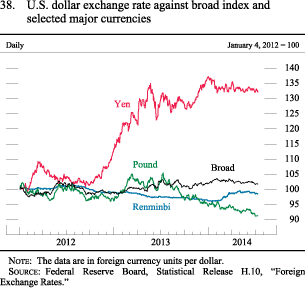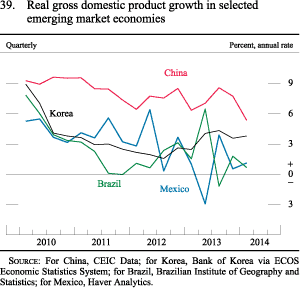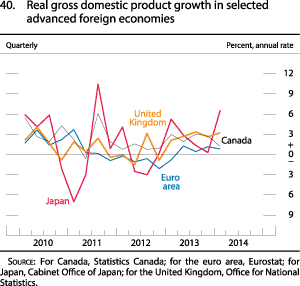- July 15, 2014: Summary
- Part 1
- Part 2
- Part 3
- Abbreviations
- Printable Version (1.26 MB PDF)

Sections of Part 1
Part 1: Recent Economic and Financial Developments
Monetary Policy Report submitted to the Congress on July 15, 2014, pursuant to section 2B of the Federal Reserve ActLabor market conditions continued to improve over the first half of this year. Gains in payroll employment since the start of the year have averaged about 230,000 jobs per month, up a little from the average pace in 2013, and the unemployment rate declined to 6.1 percent in June, the lowest rate recorded in more than five years. Nevertheless, the jobless rate is still above Federal Open Market Committee (FOMC) participants' estimates of the longer-run normal rate. Other measures of labor utilization, as well as the continued slow increases in most measures of labor compensation, generally corroborate the view that significant slack remains in the labor market. Inflation, as measured by the price index for personal consumption expenditures (PCE), averaged 1-3/4 percent over the 12 months ending in May, higher than the unusually low level over the preceding 12 months but still somewhat below the Committee's 2 percent objective. Meanwhile, both survey- and market-based measures of longer-term inflation expectations have remained quite stable. Real gross domestic product (GDP) was reported to have decreased in the first quarter of this year, but the available information for the second quarter suggests that the decline was transitory. One area of concern, however, is the housing sector, where activity softened by more, relative to its earlier trajectory, than would have been expected based on last year's rise in mortgage interest rates. Financial conditions have generally remained supportive of economic growth. Longer-term interest rates in the United States as well as in most other advanced economies have partially reversed last year's increases, and borrowing conditions for households and small businesses have slowly improved, while credit flows to large nonfinancial corporations have remained strong.
Domestic Developments
Labor market conditions have strengthened further...
The labor market continued to improve in the first half of 2014. Payroll employment has increased by an average of about 230,000 per month so far this year, higher than the average gain in 2013 (figure 1). The unemployment rate continued to trend down, declining from 6.7 percent in December 2013 to 6.1 percent in June of this year, while the labor force participation rate was little changed, on net, over the first half of this year after having moved down considerably in the second half of last year (figure 2). The unemployment rate has declined nearly 4 percentage points from its peak in 2009, although it remains elevated when judged against FOMC participants' estimates of the longer-run normal rate. Payrolls have reversed the cumulative job losses that occurred over the last recession, though that recovery has been achieved in the context of a larger population and labor force.
An index constructed by Board staff that aims to summarize movements in a broad array of labor market indicators also suggests that labor market conditions have strengthened further this year (figure 3).1 While increases in that index slowed a touch at the beginning of this year, partly reflecting the effects of the unseasonably cold and snowy weather this winter, the pace has picked up again in recent months.
...but significant slack remains...
Notwithstanding those improvements, various labor market indicators suggest that a significant degree of slack remains in labor utilization. For instance, measures of labor underutilization that incorporate broader definitions of unemployment are still well above their pre-recession levels, even though they have moved down further this year (figure 4). The proportion of workers employed part time because they are unable to find full-time work has similarly declined but remains elevated, and hiring and quit rates are still below their pre-recession norms. Moreover, the median duration of unemployment is still well above its long-run average.
The declines in the participation rate during the past few years, within the context of a strengthening labor market, also could be an indication of continuing labor market slack. To be sure, movements in the participation rate partly reflect the changing demographic composition of the population, most notably the increasing share of older persons, who have lower-than-average participation rates because they are more likely to be retired. As such, many of those exits from the labor force probably would have occurred even if the labor market had been stronger. However, some exits are likely occurring because the prolonged period of high unemployment has led some individuals to give up their job search, and such dynamics could have harmful consequences for economic activity in the long run.
...and wage growth has remained tepid
Continued slow increases in most measures of labor compensation offer further evidence of labor market slack. Compensation per hour in the nonfarm business sector is estimated to have risen at a modest pace of 2-1/4 percent over the four quarters ending in the first quarter of this year; the employment cost index for private industry workers rose at an annual rate of only 1-3/4 percent in the same period; and average hourly earnings rose about 2 percent over the 12 months ending in June, little changed from the average rate of increase in hourly earnings during the past several years (figure 5). Over the past five years, the various measures of nominal hourly compensation have increased roughly 2 percent per year, on average, and after adjusting for inflation, growth of real compensation has fallen short of the gains in productivity over this period.
Consumer price inflation has moved up...
Inflation has moved higher this year following unusually low readings in 2013. The PCE price index rose 1-3/4 percent over the 12 months ending in May, up from the 1 percent increase recorded over the preceding 12 months (figure 6). The PCE price index excluding food and energy items rose 1-1/2 percent over the 12 months ending in May, slightly less than the overall index. The FOMC continues to judge that inflation at the rate of 2 percent, as measured by the annual change in the PCE price index, is most consistent over the longer run with the Federal Reserve's statutory mandate. Thus, inflation remained somewhat below the Committee's goal. Some of the factors that contributed to the unusually low inflation in 2013, such as the softness seen in non-oil import prices, have begun to unwind and are pushing up inflation a little this year. More generally, however, with wages growing slowly and raw materials prices generally flat or moving downward, firms are not facing much in the way of cost pressures that they might otherwise try to pass on.
A portion of the recent increase in inflation reflects movements in energy and food prices that appear transitory. Consumer energy prices rose at an annual rate of nearly 6 percent over the 12 months ending in May, partly reflecting strong demand for electricity and natural gas during the cold winter. Global oil prices have been remarkably stable for much of the past year, with oil prices remaining mostly in a narrow range of between about $105 and $110 per barrel and moving above that range only temporarily in reaction to events in Iraq (figure 7). Meanwhile, adverse growing conditions in both the United States and abroad have pushed up wholesale prices for various food commodities--including corn, wheat, and coffee--and these higher raw materials prices have led to somewhat larger increases in consumer food prices this year.
...but inflation expectations have changed little
Survey- and market-based measures of inflation expectations at medium- and longer-term horizons have remained quite stable throughout the recent period. Readings on inflation expectations 5 to 10 years ahead, as reported in the Thomson Reuters/University of Michigan Surveys of Consumers, have continued to move within a narrow range (figure 8). In the Survey of Professional Forecasters, conducted by the Federal Reserve Bank of Philadelphia, the median expectation in the second quarter for the annual rate of increase in the PCE price index over the next 10 years was 2 percent, similar to its level in recent years. Meanwhile, market-based measures of medium- (5-year) and longer-term (5-to-10-years-ahead) inflation compensation derived from differences between yields on nominal Treasury securities and Treasury Inflation-Protected Securities have also remained within their respective ranges observed over the past few years (figure 9).
The first-quarter decline in real GDP appears to have been transitory
Measures of real aggregate output--that is, GDP and gross domestic income--were both reported to have declined in the first quarter of this year (figure 10).2 . Part of the weakness in output was likely related to severe weather early in the year.3 But much of the drop in first-quarter GDP reflected unusually large swings in inventories and net exports, two volatile categories for which the available monthly data point to a rebound in the second quarter. In addition, a number of recent indicators of second-quarter spending, including motor vehicle sales, retail sales, and shipments of capital goods, suggests that the overall pace of consumer and business spending also picked up in the second quarter. Expansion in real activity continues to be supported by ongoing job gains, a waning drag from fiscal policy, and accommodative financial conditions. However, activity in the housing sector has yet to show persistent gains since it slowed in the wake of last year's rise in mortgage interest rates.
Export declines weighed heavily on first-quarter GDP
Real exports of goods and services declined at an annual rate of about 9 percent in the first quarter of 2014 (figure 11), coinciding with a global slowdown in trade. The decline partly reflected a retrenchment in two volatile categories, petroleum and agriculture, that had surged in the fourth quarter of 2013. With real imports of goods and services advancing in the first quarter, albeit slowly, net exports subtracted 1-1/2 percentage points--an unusually large amount--from overall GDP growth. However, available data for April and May indicate that exports rebounded in the second quarter, and net exports will likely be more supportive of growth in the second quarter.
The current account deficit widened somewhat in the first quarter of this year after having narrowed further over 2013; however, measured relative to nominal GDP, the deficit remains near its narrowest readings since the late 1990s (figure 12). In the second half of 2013, the current account deficit continued to be financed mostly by purchases of Treasury and corporate securities by both foreign official investors and foreign private investors (figure 13). Foreign private purchases remained strong in the first quarter of 2014, but official inflows weakened as conditions in emerging market economies (EMEs) worsened early in the quarter.
Gains in wealth and income are supporting consumer spending
Smoothing through weather-related fluctuations, consumer spending was reported to have risen at a modest annual rate of 1 percent over the first five months of this year, while disposable personal income advanced at a stronger pace of 2-1/4 percent over the same period (figure 14).4 The faster pace of job gains so far this year has helped improve the economic prospects of many households and has contributed to a pickup in the pace of aggregate income growth, though it is not yet clear how widely these income gains have been shared across the population. In addition, personal tax payments and social security contributions, which surged last year as a consequence of higher federal payroll and income taxes, are no longer weighing as heavily on income growth.
Consumption growth this year also has been supported by ongoing gains in household net worth. House prices, which are of particular importance for the wealth position of many middle-income households, have continued to move higher, with the CoreLogic national index showing a rise of almost 9 percent over the 12 months ending in May (figure 15). Meanwhile, the value of corporate equities has risen more than 15 percent over the past year and has added substantially to net wealth. Reflecting those solid gains, aggregate household net wealth is estimated to have approached 6-1/2 times the value of disposable personal income in the first quarter of this year, the highest level observed for that ratio since 2007 (figure 16).
Coupled with low interest rates, the rise in incomes has enabled many households to reduce their debt payment burdens. The household debt service ratio--that is, the ratio of required principal and interest payments on outstanding household debt to disposable personal income--dropped further in the first quarter of this year and stood at a very low level by historical standards (figure 17).
Borrowing conditions for households are slowly improving...
The improvements in households' balance sheets so far this year have been accompanied by a gradual easing in borrowing conditions. For example, large banks reported a net easing of standards for home purchase loans to prime borrowers in the Federal Reserve Board's April 2014 Senior Loan Officer Opinion Survey on Bank Lending Practices (SLOOS).5 SLOOS responses also indicated a net easing in credit standards for consumer loans. Even so, mortgage lending standards have remained tight for many households; indeed, standards on nontraditional mortgage loans were reported to have tightened further in the April survey. Likely reflecting, in part, the increased willingness to lend, the rate of decline in mortgage debt has slowed so far this year, and growth in other consumer credit has been robust (figure 18).
...but consumer confidence remains tepid
Despite the strengthening in household incomes and wealth, indicators of consumer sentiment still appear somewhat depressed compared with their longer-run norms. The Michigan survey's index of consumer sentiment--which incorporates households' views about their own financial situations as well as broader economic conditions--has recovered noticeably from its recessionary low but has changed little, on net, over the past year (figure 19). The responses to a separate survey question about income expectations display a similar pattern: Although an index of households' expectations of real income changes in the year ahead has recovered somewhat since 2011, it remains substantially below the historical average and suggests a more guarded outlook than the headline index.
Business investment has been lackluster,...
After recording modest gains in 2013, business fixed investment ticked down in the first quarter of this year, as a large decline in spending on nonresidential structures was partly offset by a small increase in outlays for equipment and intangible (E&I) capital (figure 20). Although the expiration of a tax provision allowing 50 percent bonus depreciation may have pulled some capital investment forward into late 2013, looking over a longer period, the pattern of investment outlays over the past year and a half appears broadly consistent with the sluggish pace of business output growth during the period. Nevertheless, various forward-looking indicators, such as business sentiment and earnings expectations of capital goods producers, paint a fairly upbeat picture and point to a pickup in the growth of E&I investment.
Business investment in structures has been relatively weak this year, as demand for nonresidential buildings continues to be restrained by high vacancy rates for existing properties and tight financing conditions for new construction. However, the level of investment in drilling and mining structures is extremely high by historical standards, a reflection of the boom in oil and natural gas extraction.
...even as corporate borrowing has expanded and loan terms and standards appear to be easing
The financial condition of large nonfinancial firms has remained strong so far this year, with profitability high and the default rate on nonfinancial corporate bonds generally low. Nonfinancial firms have continued to raise funds at a robust pace, given strong corporate credit quality and historically low interest rates on corporate bonds (figure 21). Indeed, bond issuance by both investment- and speculative-grade nonfinancial firms has been strong (figure 22).
Moreover, credit availability in business loan markets has shown further improvement. According to the April SLOOS, banks again eased standards on commercial and industrial (C&I) loans to firms of all sizes in the first quarter, and many banks have eased price-related and other terms on such loans. In addition, according to the Federal Reserve Board's May 2014 Survey of Terms of Business Lending, loan rate spreads over market interest rates for newly originated C&I loans have continued to decline. In this environment, C&I loans on banks' books and commercial paper outstanding both have registered solid increases. Issuance of leveraged loans continued to be rapid in the first half of 2014, and issuance of collateralized loan obligations reached very high levels in the period from February to April.6 Small business lending activity has picked up as well in recent months, likely reflecting some increase in credit availability as well as a strengthening in businesses' demand for credit.
In the commercial real estate (CRE) sector, loans continued to expand at a moderate pace, and increases in banks' CRE loans remained widespread across all major CRE segments (that is, loans secured by nonfarm nonresidential properties, multifamily residential properties, and construction and land development loans). According to the April SLOOS, standards on CRE loans extended by banks also eased in the first quarter. Special survey questions asked about changes in terms on CRE loans over the past year, and many banks reported having eased interest rate spreads and increased maximum loan sizes and terms to maturity. Nevertheless, standards for construction and land development loans appear to have remained relatively tight.
The drag from federal fiscal restraint is waning...
Fiscal policy has been a contractionary force through most of the past three years and was especially so in 2013, when the temporary payroll tax cut expired, taxes increased for high-income households, and federal purchases were pushed down by the sequestration and caps on discretionary spending (figure 23). Moreover, in the fourth quarter of last year, disruptions related to the government shutdown led to a sharp but temporary reduction in federal purchases. For 2013 as a whole, real federal purchases (as measured in the national income and product accounts) fell 6-1/4 percent, twice as large as the average decline in the previous two years.
This year, however, fiscal policy has become somewhat less restrictive for GDP growth, as the effects of the 2013 tax and spending changes are fading. While the expiration of emergency unemployment compensation at the beginning of the year has exerted a drag on consumer spending, medical benefits provided for under the Affordable Care Act will likely support increased consumption of medical services.
With few major changes in tax policy in 2014, federal receipts have edged up to around 17 percent of GDP, their highest level since before the recession (figure 24). Meanwhile, nominal federal outlays as a share of GDP have continued to trend downward but have remained above the levels observed before the start of the recession. Thus, the federal unified budget deficit has narrowed again this year; the Congressional Budget Office projects that the budget deficit for fiscal year 2014 as a whole will be 3 percent of GDP, compared with the fiscal 2013 deficit of 4 percent of GDP. Overall federal debt held by the public has continued to rise, and the ratio of nominal federal debt to GDP moved up to near 75 percent in early 2014 (figure 25).
...and state and local government expenditures are turning up
At the state and local level, the ongoing strengthening in economic activity, as well as previous spending cuts, has helped foster a gradual improvement in the budget situations of most jurisdictions. Consistent with improving sector finances, states and localities have been expanding their workforces; employment accelerated in the first half of the year after rising modestly in the second half of 2013 (figure 26). Construction expenditures by those governments, however, have yet to show a sustained recovery.
The recovery in the housing market has lost traction
After proceeding briskly in 2012 and the first half of 2013, the recovery in residential construction seems to have faltered. Real residential investment declined for two successive quarters around the turn of the year, and the available data point to only a modest gain in the second quarter (figure 27). The renewed softness of late has proven more extensive and persistent than would have been expected given the rise in mortgage interest rates around the middle of last year (see the box "The Slow Recovery of Housing Activity"). That said, household formation remains depressed relative to demographic norms, and the ongoing improvement in labor market conditions could help spur a more decisive return to those norms.
The Slow Recovery of Housing Activity
Partly because of its sensitivity to interest rates, investment in residential structures has often played an important role in jump-starting economic recoveries, even though it has constituted less than 5 percent of gross domestic product (GDP), on average, since World War II. For example, in 1983, coming out of a severe double-dip recession, residential investment rose 50 percent and contributed 1.7 percentage points to GDP growth. But the recent recovery period has been quite different from previous episodes, even with interest rates at historically low levels. In 2010 and 2011, the first two years of the recovery, residential investment contributed essentially nothing, on average, to the growth of real GDP. Even after rising noticeably in 2012 and the first half of 2013, real residential investment remains 45 percent below its pre-recession peak. The lack of a rapid housing recovery has also affected the labor market: Employment in the construction sector is still more than 1.6 million lower than the average level in 2006.
The failure of residential construction to significantly boost the current recovery likely reflects a number of headwinds. First, a much tighter supply of mortgage credit in the aftermath of the housing bubble, particularly for prospective borrowers with low credit scores, has crimped demand for owner-occupied housing. Second, the slow recovery of the labor market has significantly reduced the pace of new household formation, as young adults in particular have become more likely to live with their parents or other relatives. Third, the relatively rapid recovery of house prices, even as construction remains far below trend, suggests that constraints on new housing supply also have played a role. These constraints may include shortages of skilled labor and buildable lots, implying that some time may be required to shift resources back into the sector.
Despite these headwinds, housing activity began to recover in late 2011, supported by declining unemployment, record-low longer-term interest rates, and improving confidence in the economic recovery. Single-family housing starts and sales of existing homes both trended up in 2012 and continued to do so through mid-2013 (figures A and B). During this period, multifamily construction recovered to its average pace in the 1990s and early 2000s, supported by a shift in the composition of demand toward rental units driven by many of the same factors that have constrained the single-family, owner-occupied sector. All told, from the fourth quarter of 2011 through the second quarter of 2013, residential investment (as measured in the national income and product accounts) grew at an average annual rate of nearly 15 percent. All of the major components of residential investment--including construction of new single-family and multifamily homes, improvements to existing structures, and brokers' commissions and fees--made sizable positive contributions to investment growth over the period (figure C).
In spite of this positive momentum, the recovery stalled in mid-2013 in the wake of a spike in mortgage interest rates that sharply reduced housing affordability (Figure D). Permits for single-family construction--the best gauge of underlying activity in the sector--have been roughly flat over the past year. Meanwhile, existing home sales have fallen almost 10 percent from their recent highs. Residential investment turned sharply negative for two successive quarters around the turn of the year. Measures of builder, real estate agent, and homebuyer sentiment have also deteriorated. Arguably, the only bright spot of late has been the data on multifamily starts and permits, which are noisy but appear to have continued to trend higher on net.
While the most obvious explanation for the weakness in the housing market over the past year is the run-up in mortgage rates during the spring and summer of 2013, it seems unlikely that interest rates are the whole story. Historical correlations between mortgage rates and residential investment suggest that the effects of last year's run-up should have begun to fade by now, but housing activity has yet to pick up. Moreover, since last summer, mortgage rates have retraced a portion of their earlier increases without any noticeable improvement in activity.
Even so, it is possible that the interest rate spike may have had a larger and longer-lasting effect than would be suggested by historical experience, especially because an interest rate rise of that magnitude, with rates so low and housing activity so depressed, is unprecedented. Alternatively, ongoing increases in house prices may indicate that constraints on the supply of new housing are binding more significantly than seemed to be the case in 2012, when residential investment rose fairly rapidly. Finally, the downturn in existing home sales, which has had a particularly pronounced effect on total residential investment via brokers' commissions, may reflect factors specific to the resale market; in particular, short sales and sales of foreclosed properties have declined markedly over the past couple of years.
Regardless of what explains the recent weakness, the level of new home construction likely remains much too low to be sustainable. Prior to the housing boom and bust, an average of roughly 1-3/4 million housing units were started per year.1 In comparison, only about 1 million units were started in 2013, despite the recovery of multifamily starts to pre-recession levels. It is difficult to judge when construction will resume its upward trend or, given all of the changes in the housing market in recent years, at what level it will stabilize. That said, the Census Bureau projects that the adult population will continue to grow by roughly 2 million per year over the next two decades; with that rate of population growth, the pace of construction seems likely to rise from current levels.
Footnotes
1. This figure is calculated using data from 1960 to 2000 and includes single-family and multifamily construction as well as shipments of new mobile homes. Return to text
Productivity growth has been modest
In general, gains in labor productivity have been modest in recent years. Output per hour in the nonfarm business sector has risen at an annual rate of less than 1-1/2 percent since 2007, well below the pace of gains observed over the late 1990s and early 2000s (figure 28). The relatively slow pace of productivity growth likely reflects, in part, the sustained weakness in capital investment over the recession and recovery period, and productivity gains may be better supported in the future as outlays for productivity-enhancing capital equipment strengthen.
Financial Developments
The expected path for the federal funds rate edged down
Market-based measures of the expected path of the federal funds rate through late 2017 edged down, on balance, over the first half of the year. After accounting for transitory factors such as weather, market participants appeared to judge the incoming economic data as somewhat better than they had expected but as still continuing to point to subdued inflationary pressures and an accommodative policy stance by the FOMC. The relatively small movements of the market-based measures are consistent with the results of the most recent Survey of Primary Dealers and the pilot survey of market participants, each conducted just prior to the June FOMC meeting by the Open Market Desk at the Federal Reserve Bank of New York. Those surveys suggest that dealers and buy-side respondents both anticipate that the initial increase in the target federal funds rate from its current range will occur in the third quarter of 2015, slightly earlier than dealers had anticipated at the beginning of this year and about the same as what buy-side respondents had anticipated.7
Finally, while some forward measures of policy rate uncertainty have risen, overall policy rate uncertainty has generally remained relatively low.
However, Treasury yields declined significantly, especially at longer maturities, as have sovereign bond yields in other advanced economies
After rising notably over the spring and summer months of 2013, yields on longer-term Treasury securities drifted down over the first half of 2014 and now stand at fairly low levels by historical standards (figure 29). In particular, while the yield on 5-year nominal Treasury securities edged down only about 5 basis points from its level at the end of December 2013, the yields on the 10- and 30-year securities decreased about 50 basis points and 60 basis points, respectively. The decline in longer-term yields reflects a notable reduction in longer-horizon forward rates, with the 5-year-forward rate 5 years ahead dropping about 105 basis points since year-end. Five-year-forward inflation compensation over this period declined 20 basis points, implying that much of this reduction in nominal forward rates was concentrated in forward real rates. Yields on 30-year agency mortgage-backed securities (MBS) decreased about 35 basis points, on balance, over the same period (figure 30).
Long-term benchmark sovereign yields in advanced foreign economies (AFEs) have also moved down since late last year, with particularly marked reductions in the euro area (figure 31). Market participants have pointed to several potential explanations for the declines in U.S. and foreign yields. One possible explanation is that market participants have lowered their expectations for future short-term interest rates around the globe. This downward adjustment in expectations may be due to a combination of a lower assessment of the global economy's long-run potential growth rate and a decrease in long-run inflation expectations. Indeed, the lower yields in the euro area are consistent with indications of declining inflation and weak growth in the euro area in recent months, bolstering expectations that the European Central Bank (ECB) would loosen its monetary policy, as it eventually did at its meeting in early June.
In addition, term premiums--the extra return investors expect to obtain from holding longer-term securities as opposed to holding and rolling over a sequence of short-term securities for the same period--may have come down, reflecting several potential factors. One potential factor is a reduction in the amount of compensation for interest rate risk that investors require to hold fixed-income securities, likely due in part to perceptions that uncertainty about the outlook for monetary policy and economic growth has decreased; indeed, swaption-implied volatility on longer-term rates has fallen noticeably since the beginning of the year. Another potential factor is increased demand for Treasury securities from price-insensitive investors, such as pension funds and commercial banks. Lastly, in light of the notable co-movements between forward interest rates at longer horizons in the United States and other advanced economies, it appears likely that there is a global component of term premiums that is affected not only by U.S. developments, but also by foreign developments, such as investors becoming increasingly confident that policy rates at the major foreign central banks will remain low for an extended period.
Broad equity price indexes increased further, and risk spreads on corporate debt declined
Although equity investors appeared to pull back from the market for a time early in the year in reaction to concerns about the strength of some EMEs and the possible implications for global growth, broad measures of U.S. equity prices have posted solid gains of 6 percent since the beginning of 2014, on balance, after having risen 30 percent in 2013 (figure 32). Overall, equity investors appeared to become more confident in the near-term economic outlook amid somewhat better-than-expected economic data releases, declining longer-term interest rates, and upward revisions to expected year-ahead earnings per share for firms in the S&P 500 index.
Some broad equity price indexes have increased to all-time highs in nominal terms since the end of 2013. However, valuation measures for the overall market in early July were generally at levels not far above their historical averages, suggesting that, in aggregate, investors are not excessively optimistic regarding equities. Nevertheless, valuation metrics in some sectors do appear substantially stretched--particularly those for smaller firms in the social media and biotechnology industries, despite a notable downturn in equity prices for such firms early in the year. Moreover, implied volatility for the overall S&P 500 index, as calculated from option prices, has declined in recent months to low levels last recorded in the mid-1990s and mid-2000s, reflecting improved market sentiment and, perhaps, the influence of "reach for yield" behavior by some investors.
Credit spreads in the corporate sector have also declined, on balance, in recent months. After having temporarily increased early in the year, the spreads of yields on corporate bonds to yields on Treasury securities of comparable maturities ended the first half of the year about unchanged or a bit narrower. Credit spreads on high-yield corporate bonds are near the bottom of their range over the past decade. While spreads on syndicated loans have changed little this year, they are also relatively low. For further discussion of asset prices and other financial stability issues, see the box "Developments Related to Financial Stability."
Developments Related to Financial Stability
Pressures within the U.S. financial system that could leave it vulnerable to adverse events do not appear to have increased appreciably this year. In the current economic environment, the Committee views low interest rates as necessary to support progress toward price stability and maximum sustainable employment. Policymakers have noted the possibility that a prolonged period of low interest rates may provide incentives for some investors to "reach for yield," and those actions could increase vulnerabilities in the financial system. Asset prices for real estate, equities, and corporate bonds have risen and valuation measures have increased, but valuations have remained generally in line with historical norms. Moreover, despite brisk borrowing by the business sector, aggregate private nonfinancial debt has increased at only a moderate pace, and the financial strength of the banking sector has continued to improve. Substantial progress has been made to reduce structural vulnerabilities in the financial system, although this work is ongoing.
With regard to asset valuations, house prices have continued to increase, but, for the most part, these increases have left aggregate price-to-rent ratios within historical norms. Moreover, growth in residential mortgage debt has remained anemic, suggesting that the recent increases are not fueled by excessively aggressive lending conditions. More broadly, aggregate measures of the household debt burden appear reasonable despite recent rapid growth in auto lending and student loans, which has strained some borrowers, particularly those in the lower half of the income distribution.
However, signs of risk-taking have increased in some asset classes. Equity valuations of smaller firms as well as social media and biotechnology firms appear to be stretched, with ratios of prices to forward earnings remaining high relative to historical norms. Beyond equities, risk spreads for corporate bonds have narrowed and yields have reached all-time lows. Issuance of speculative-grade corporate bonds and leveraged loans has been very robust, and underwriting standards have loosened. For example, average debt-to-earnings multiples have risen, and the share rated B or below has moved up further for leveraged loans. The Federal Reserve continues to closely monitor developments in the leveraged lending market and, in conjunction with other federal agencies, is working to enhance compliance with previous guidance on issuance, pricing, and underwriting standards.1
The financial strength of the banking sector has continued to improve. Bank holding companies (BHCs) have pushed up their regulatory capital ratios, continuing a trend seen since the first set of government stress tests in 2009. The sector's aggregate Tier 1 common equity ratio, which compares high-quality capital to risk-weighted assets for all BHCs, has more than doubled, from 5.5 percent in the fourth quarter of 2008 to 11.7 percent in the first quarter of 2014. In addition, all of the domestic systemically important banking organizations met their minimum Tier 1 common equity ratios, including the capital surcharge, required under Basel III rules. Moreover, BHCs have continued to strengthen their liquidity positions in recent quarters and have become less reliant on wholesale short-term funding.
Strong capital and liquidity positions help ensure that banking organizations have the ability to lend to households and businesses and to continue to meet their financial obligations, even in times of economic difficulty. Results of the most recent set of stress tests were released in March 2014. Thirty BHCs participated in the stress tests. These institutions have a combined $13.5 trillion in assets, or approximately 80 percent of all U.S. BHC assets. The Dodd-Frank Act stress test (DFAST), mandated by the Dodd-Frank Wall Street Reform and Consumer Protection Act of 2010, and the Comprehensive Capital Analysis and Review (CCAR) continue to enhance supervisors' understanding of the underlying processes used by each BHC to assess the adequacy of the size and composition of its capital relative to the risks it faces. Under the "severely adverse" DFAST scenario, all but one of the participating BHCs exceeded minimum capital requirements. Furthermore, under CCAR, the Federal Reserve Board granted nonobjections to the capital plans of 24 BHCs.2
Recent results from the Senior Credit Officer Opinion Survey on Dealer Financing Terms indicate that the use of financial leverage by respondents' counterparties to purchase securities has not changed notably in recent quarters, although demand for financing commercial mortgage-backed securities and collateralized loan obligations (CLOs) has been rising recently. However, aggregate measures of the use of short-term wholesale funding to finance assets remained roughly unchanged over the past couple of years. Similarly, securitization, which continues to be an important means of financing, has been modest, though issuance of CLOs has increased.
Moving beyond recent developments, important structural vulnerabilities remain that could leave the U.S. financial system exposed to adverse events. Despite the increase in resilience within the banking sector highlighted by the stress tests, the broader financial system remains highly interconnected. While stronger capital and liquidity positions in the banking sector should help reduce the consequences of this structural vulnerability, the Federal Reserve nevertheless continues to encourage firms to better manage their exposures to large counterparties and to improve their recovery and resolution plans. The Federal Reserve is also working to strengthen the infrastructure of derivatives markets--for instance, by working with other agencies on rules to establish initial and variation margin requirements for over-the-counter derivatives transactions. The potential for runs on money market mutual funds in the event of a severe liquidity or credit shock remains significant, and this risk will continue to pose a threat to financial stability until further structural reforms are adopted, as recommended by the Financial Stability Oversight Council.
The Federal Reserve has taken a number of steps to continue improving the resiliency of the financial system. Some regulatory reforms taken since the previous Monetary Policy Report are highlighted here. Pursuant to section 165 of the Dodd-Frank Act, the Federal Reserve Board approved a final rule strengthening the supervision and regulation of large U.S. BHCs and foreign banking organizations. The rule establishes enhanced prudential standards with respect to capital, liquidity, and risk management. It also requires foreign banking organizations with a significant U.S. presence to establish an intermediate holding company over their U.S. subsidiaries, which will facilitate consistent supervision and regulation of the U.S. operations of these foreign banks.
Furthermore, together with other federal agencies, the Federal Reserve Board adopted a final rule to strengthen the leverage ratio standards for the largest, most interconnected U.S. banking organizations. The final rule applies to top-tier U.S. BHCs with more than $700 billion in consolidated total assets or more than $10 trillion in assets under custody and to their insured depository institution subsidiaries. These BHCs must maintain a leverage buffer greater than 2 percentage points above the minimum supplementary leverage ratio requirement of 3 percent, for a total of more than 5 percent, to avoid restrictions on capital distributions and discretionary employee bonus payments. Insured depository institution subsidiaries of these BHCs must maintain at least a 6 percent supplementary leverage ratio to be considered "well capitalized" under the agencies' prompt corrective action framework. The final rule has an effective date of January 1, 2018. The Federal Reserve Board is also working on proposals for additional risk-based capital surcharges and long-term debt requirements for global, systemically-important banking organizations based in the United States.
The Federal Reserve Board also issued a notice of proposed rulemaking to implement section 622 of the Dodd-Frank Act. Section 622 establishes a financial-sector concentration limit that prohibits a financial company from merging with, acquiring, or consolidating with another company if the ratio of the resulting financial company's liabilities to the aggregate consolidated liabilities of all financial companies exceeds 10 percent. The proposed rule spells out the details involved in calculating the limit.
Footnotes
1. In March 2013, the Federal Deposit Insurance Corporation, the Federal Reserve, and the Office of the Comptroller of the Currency issued joint supervisory guidance on leveraged lending practices, which became effective in May 2013. Since that time, there has been strong supervisory follow-up to ensure compliance, in the form of supervisory reviews throughout 2014 and the issuance of supervisory letters, including specific Matters Requiring Attention. See Board of Governors of the Federal Reserve System, Division of Banking Supervision and Regulation (2013), "Interagency Guidance on Leveraged Lending," Supervision and Regulation Letter SR 13-3 (March 21), www.federalreserve.gov/bankinforeg/srletters/sr1303.htm. Return to text
2. Initially, the Federal Reserve Board granted nonobjections to the capital plans of 25 firms, but the nonobjection granted to the 25th firm was withdrawn after that firm restated its capital position. Return to text
Treasury market functioning and liquidity conditions in the MBS market were generally stable...
Indicators of Treasury market functioning remained stable amid ongoing reductions in the pace of the Federal Reserve's asset purchases over the first half of 2014. In particular, liquidity conditions in Treasury markets remained stable, with with bid-asked spreads in the Treasury market staying in line with recent averages. In addition, the Treasury's first-ever auction of a Floating Rate Note in January was well received, as were subsequent auctions of those notes.
Liquidity conditions in the MBS markets were also generally stable, though there have been some signs of scarcity of certain securities, as evidenced by somewhat low levels of implied financing rates in the production-coupon "dollar roll" markets during the first half of this year. However, the implied financing rates rose in recent days, suggesting easing of settlement pressures in these markets of late (figure 33).8 Gross issuance of these securities remained somewhat lower than in the past two years, reflecting relatively low mortgage originations.
...and short-term funding markets also continued to function well
Conditions in short-term dollar funding markets also remained stable during the first half of 2014. Early in the year, yields on Treasury bills maturing between late February and mid-March of 2014--those that could have been affected by delayed payments if a debt ceiling agreement had not been reached--were elevated for a time, but those yields declined in mid-February in response to news of pending legislation to suspend the debt ceiling until March 2015. The federal funds rate remained at very low levels, and broader measures of unsecured dollar bank funding costs, such as the LIBOR, or London interbank offered rate, remain at very low levels, reflecting the absence of major funding pressures.
Money market participants continued to focus on the Federal Reserve's testing of its monetary policy tools. Daily awards at the overnight reverse repurchase agreement (ON RRP) exercise have ranged between about $50 billion and about $340 billion since early 2014. The number of counterparties participating and the dollar volume of take-up have been sensitive to the spread between market rates for repurchase agreements and the fixed ON RRP rate offered in the exercise.9 Indeed, take-up has been large at quarter-ends, when balance sheet adjustments by financial institutions tend to limit other investment options. Experience to date suggests that ON RRP operations have helped establish a floor on money market interest rates. Testing of the Term Deposit Facility, as well as take-up of and participation in its test offerings, has expanded during the first half of 2014. (For further discussion of the testing of monetary policy tools, see the box "Planning for Monetary Policy Implementation during Normalization" in Part 2.)
The condition of financial institutions improved further, although profitability remained below its historical average
Regulatory capital ratios at bank holding companies (BHCs) increased further during the first half of 2014, and measures of bank liquidity remained robust. In addition, credit quality at BHCs continued to improve across major loan categories, and the ratios of loss reserves to delinquencies and to charge-offs each edged up. At the same time, standard measures of the profitability of BHCs have been little changed for the past six months (figure 34). Profitability of these companies remained below its historical average, in part because of subdued income from mortgage and trading businesses and compressed net interest margins at large banks. A few large banks have also incurred sizable costs from legal settlements associated with the origination of mortgages prior to the recent financial crisis. Aggregate credit provided by commercial banks grew at a solid pace in the first half of 2014 (figure 35). The increase was driven by a pickup in loan growth and a rise in holdings of U.S. Treasury securities that was reportedly influenced by banks' efforts to meet new liquidity regulations. Equity prices of large domestic banks increased a bit from the beginning of the year, on net, but underperformed the overall market, as shown in figure 32. Credit default swap (CDS) spreads for large BHCs remain low.
Among nonbank financial institutions, equity prices of insurance companies have also increased slightly, on net, since the beginning of the year. Nonbank financial institutions continued to grow at a very strong pace, as assets under management at hedge funds and private equity groups each reached record highs, reflecting modest increases in asset values as well as net inflows. Nevertheless, in response to the Federal Reserve Board's Senior Credit Officer Opinion Survey on Dealer Financing Terms for March and June, most dealers indicated that hedge funds had not changed their use of leverage since the beginning of the year (figure 36).10 In the same survey, some dealers noted that the use of financial leverage by trading REITs, or real estate investment trusts, had decreased, continuing a trend that began in the summer of 2013. Assets under management at bond mutual funds also reached a record high.
Municipal bond markets functioned smoothly, but some issuers remained strained
Credit conditions in municipal bond markets generally appeared to remain stable over the first half of the year. Yields on 20-year general obligation municipal bonds have declined slightly since the beginning of the year, and the MCDX, an index of CDS for a broad portfolio of municipal bonds, has also moved down. However, the ratio of an index of municipal bond yields to Treasury yields has increased a bit.
Nevertheless, significant financial strains have been evident for some issuers. Standard & Poor's, Moody's Investors Service, and Fitch Ratings downgraded Puerto Rico's general obligation bonds from investment grade to speculative grade in February. In addition, the City of Detroit continues to negotiate the terms of its bankruptcy plan.
Liquid deposits in the banking sector continued to advance briskly, boosting M2
M2 has increased at an annual rate of about 7 percent since December, about the same pace registered in the second half of 2013 and somewhat faster than the pace of nominal GDP. The growth in M2 has been driven by an increase in liquid deposits as well as an uptick in demand for currency.
International Developments
As in the United States, foreign bond yields declined and asset prices increased, on net...
As noted earlier, foreign long-term benchmark sovereign yields have moved significantly lower since the beginning of the year. Factors contributing to the decline include expectations for lower policy interest rates, a decline in the required compensation for risk, and increased demand by price-insensitive investors for these assets. Similarly, foreign corporate and sovereign yield spreads have also declined since the start of the year. In particular, peripheral euro-area sovereign yield spreads narrowed substantially, on balance, as financial stresses in the euro area have eased and central banks in the advanced economies have emphasized that they will keep monetary policy accommodative for some time, though spreads in a few economies have moved up more recently. Sovereign yield spreads in EMEs have also declined, on net, consistent with measures adopted by EME central banks to reduce vulnerabilities and with the general increase in the prices for risky assets.
Foreign equity indexes rose, on net, during the first half of the year (figure 37). Stock prices increased, on balance, in most of the AFEs. Japanese equities underperformed early in the year, but they have moved up recently on stronger-than-expected incoming economic data. And European bank stock prices declined lately in part on concerns over troubles at several banks. Equities in most EMEs have also moved higher, as market sentiment toward these economies has continued to improve. However, the Chinese stock market fell on concerns over the economic outlook. Realized volatility across most financial markets and countries has declined since January, in part as sentiment toward risky assets generally improved.
...and the dollar is about unchanged
The broad nominal value of the dollar is little changed, on net, since the beginning of the year (figure 38). The U.S. dollar appreciated notably against the Chinese renminbi in the first months of the year. However, the People's Bank of China has since kept the value of the renminbi steady. In contrast, the dollar depreciated against most other emerging market currencies, as financial stresses earlier in the year unwound. In addition, the dollar depreciated against the British pound, as macroeconomic conditions improved in the United Kingdom and markets moved forward their expectations for the first rate hike by the Bank of England, and also depreciated against the Japanese yen, as investors reduced their expectations for stronger policy accommodation in Japan.
Activity in the emerging market economies slowed in the first quarter but showed signs of picking up in the second quarter...
Aggregate real GDP growth in the EMEs slowed in the first quarter of this year, led by a step-down in China's economy that also weighed on activity in many of its trading partners, especially in emerging Asia (figure 39). The slowing in China reflected a sharp fall in exports, as well as a restraint on domestic demand from tighter financial conditions, as the government attempted to rein in credit. In Mexico, growth remained weak in the first quarter, likely restrained by hikes in tax rates and administered fuel prices and softer U.S. demand for Mexican exports. Brazilian real GDP rose at a tepid pace in the first quarter, extending the lackluster performance of the past two years.
Recent indicators, notably exports, suggest that EME growth picked up in the second quarter. In particular, Chinese exports grew robustly in the second quarter, reversing most of the sharp decline in February, and the authorities announced a series of small targeted stimulus measures to support growth. The improvement in Chinese growth, along with firmer growth in the advanced economies, will help boost global economic activity in the rest of emerging Asia. Growth in Mexico is also expected to step up in the second quarter, in line with U.S. manufacturing output, and recent data in Brazil point to some, albeit modest, improvement.
Inflation remained subdued in most EMEs, and central banks in some countries, such as Chile, Mexico, and Thailand, cut rates to support growth. In contrast, the central banks of a few EMEs, such as Brazil and India, where inflation remained elevated, raised policy rates.
...while economic growth in most advanced foreign economies remained moderate
Indicators suggest that average economic growth in the AFEs remained moderate in the first half of 2014 (figure 40). The severe winter weather that hampered growth in the United States also weighed on real GDP in Canada, where growth slowed to an annualized 1-1/4 percent pace in the first quarter. However, data including the purchasing managers index are consistent with Canadian growth bouncing back in the second quarter. In Japan, GDP growth surged in the first quarter at a nearly 7 percent pace, led by household spending ahead of the April hike in the Japanese consumption tax, but recent retail sales data suggest that activity fell back sharply in April. In the United Kingdom, GDP growth remained robust in the first quarter at 3-1/4 percent, and the unemployment rate fell about 1 percentage point between mid-2013 and the first quarter of 2014. The euro area's recovery continued at a subdued pace--with GDP rising at an annual rate of around 3/4 percent in the first quarter--and recent indicators point to a firming in growth in the second quarter as financial and credit conditions continue to normalize.
Inflation during the first half of the year has been around 2 percent in Canada and somewhat below that level in the United Kingdom. In Japan, the April tax hike as well as rising import prices in response to recent yen depreciation pushed up the 12-month rate of consumer price inflation in April. However, inflation excluding taxes remained much lower, and the Bank of Japan continued its aggressive program of asset purchases aimed at achieving its inflation target of 2 percent in a stable manner. In the euro area, inflation slowed to just 1/2 percent in May, and the ECB responded in June by cutting its key policy rates--taking the deposit rate into negative territory--and by announcing measures to ease credit conditions. (For further discussion of monetary policy at foreign central banks, see the box "Prospects for Monetary Policy Normalization in the Advanced Economies.")
Prospects for Monetary Policy Normalization in the Advanced Economies
Five years after the global financial crisis, policy rates in the advanced economies remain at or near record lows, and the asset holdings of several central banks remain elevated (figure A). Even as recently as mid-2013, market expectations, as implied by quotes for overnight index swaps, suggested that policy normalization in the advanced economies would occur more or less in tandem (figure B).
Since that time, however, market views on the prospective policies of the major central banks seem to have diverged. Over the past 15 months, markets have progressively revised upward, on net, the policy rate expected at the end of 2015 in the United Kingdom. These expectations, along with those for the United States, have decoupled from those for the euro area and Japan. Market expectations of policy rates in the euro area have decreased steadily over the past year, while in Japan policy rates are expected to remain low.
In part, this divergence is due to the differences in inflation and growth outlooks across these economies. The recovery has gained footing in the United Kingdom and remains on track in the United States, with the unemployment rate continuing to fall in both countries. In contrast, euro-area inflation has declined markedly, and medium-term expectations for inflation, measured both from surveys and from inflation swaps, have also edged down. Gross domestic product in the euro area has grown more slowly than in other economies. In Japan, survey-based expectations for inflation over the next 10 years have risen more than 1 percentage point since early 2013 but are still below the 2 percent target.
Indeed, recent monetary policy actions across major central banks appear to have diverged. Some central banks are beginning to take steps to prepare for normalization, though monetary policy remains accommodative. The Bank of England (BOE) stopped asset purchases in 2012, though it has maintained its asset holdings by reinvesting the proceeds of maturing assets. In addition, the BOE issued forward guidance laying out the conditions under which it will begin to raise its policy rate, and the unemployment rate has already fallen below its initially announced threshold. The Federal Reserve has reduced the pace of its asset purchases in recent months and continues to provide forward guidance regarding the eventual liftoff of the federal funds rate and its subsequent path.
In contrast, the Bank of Japan (BOJ) and the European Central Bank (ECB) continue to ease policy. The BOJ announced a substantial expansion of its asset purchases in April 2013 with its Quantitative and Qualitative Monetary Easing program and committed to continuing purchases "as long as necessary" to achieve its 2 percent inflation target, though its stated aim is to achieve that goal by April 2015. As part of the program, the BOJ is doubling the monetary base and its holdings of Japanese government bonds and exchange-traded funds. Likewise, the ECB announced a new round of stimulus measures in its June 2014 policy meeting. The ECB cut its policy rates, lowering its main lending rate to 15 basis points and its deposit rate to negative 10 basis points. The ECB also increased the provision of short-term liquidity and announced targeted longer-term refinancing operations, or TLTROs, at fixed interest rates through 2018, thus reinforcing its forward guidance that it will keep rates low for an extended period. Moreover, the ECB announced it will intensify preparatory work related to purchases of asset-backed securities.
Footnotes
1. For details on the construction of the labor market conditions index, see Hess Chung, Bruce Fallick, Christopher Nekarda, and David Ratner (2014), "Assessing the Change in Labor Market Conditions," FEDS Notes (Washington: Board of Governors of the Federal Reserve System, May 22), www.federalreserve.gov/econresdata/notes/feds-notes/2014/assessing-the-change-in-labor-market-conditions-20140522.html. Return to text
2. Gross domestic income measures the same economic concept as GDP, and the two estimates would be identical if they were measured without error Return to text
3. Manufacturing output was held down by both snow and extreme cold in parts of the country in January and February. In March, output appears to have been boosted significantly by manufacturers making up for earlier production curtailments. Factory output subsequently dropped back in April, consistent with the view that this makeup production had been achieved. Return to text
4. In its third release of quarterly GDP, the Bureau of Economic Analysis reported that consumer spending on health-care services declined in the first quarter. This estimate reflected the incorporation of census data from the U.S. Census Bureau's Quarterly Services Survey, which showed a decline in the revenues of health-care providers. By contrast, a variety of other indicators, including data on Medicaid payments as well as health-care exchange enrollments and subsidies related to the Affordable Care Act, are suggestive of greater strength in health-care spending. Return to text
5. The SLOOS is available on the Board's website at www.federalreserve.gov/boarddocs/snloansurvey. Return to text
6. New collateralized loan obligation (CLO) deals over this period were reportedly structured to address certain restrictions in the Volcker rule. In addition, the Federal Reserve Board announced that bank holding companies have until July 21, 2017, to disinvest from non-Volcker-compliant CLOs originated prior to the end of 2013. The extension for complying with the requirement reportedly alleviated the risk of forced liquidations of such instruments in the near term. Return to text
7. The results of the Survey of Primary Dealers and of the pilot survey of market participants are available on the Federal Reserve Bank of New York's website at www.newyorkfed.org/markets/primarydealer_survey_questions.html ![]() and www.newyorkfed.org/markets/pilot_survey_market_participants.html
and www.newyorkfed.org/markets/pilot_survey_market_participants.html ![]() , respectively. Return to text
, respectively. Return to text
8. Dollar roll transactions consist of a purchase or sale of agency MBS with the simultaneous agreement to sell or purchase substantially similar securities on a specified future date. The Federal Reserve engages in these transactions as necessary to facilitate settlement of its agency MBS purchases.
During April and May, the Open Market Desk transitioned purchases of agency MBS to FedTrade, the Desk's proprietary trading system that uses multiple-price competitive auctions. Return to text
9. Fixed-rate ON RRP operations were first authorized by the FOMC at the September 2013 meeting, and were reauthorized in January 2014, for the purpose of assessing operational readiness. The Committee authorized the Open Market Desk to conduct such operations involving U.S. government securities and securities that are direct obligations of, or fully guaranteed as to principal and interest by, any agency of the United States. Return to text
10. The Senior Credit Officer Opinion Survey on Dealer Financing Terms is available on the Board's website at www.federalreserve.gov/econresdata/releases/scoos.htm. Return to text
*On July 30, 2014, the data in Figure 17 were corrected to extend through 2014:Q1, as originally noted.

 Policy Implementation
Policy Implementation
